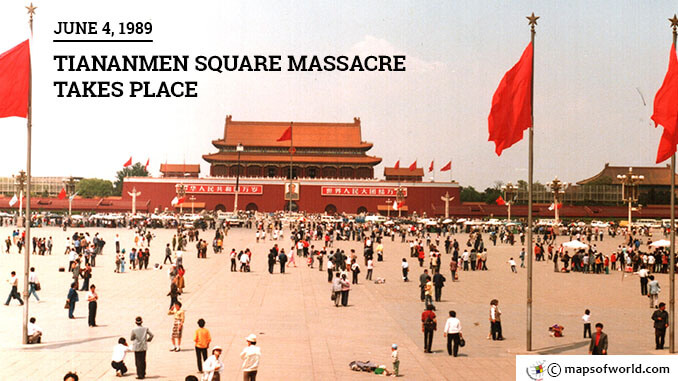On June 4, 1989, Chinese military troops massacred thousands of unarmed civilians who blocked the route to Tiananmen Square in Beijing. The Tiananmen Square had been occupied by student protesters and demonstrators several weeks prior to the incident. In late May 1989, thousands of students in Beijing gathered to take advantage of the media exposure that was to follow Soviet President Mikhail Gorbachev’s visit. They found it the perfect opportunity to stage pro-democracy demonstrations and occupied Tiananmen Square for almost a fortnight. The protests were also meant to mourn the death of liberal reformer and former Communist Party General Secretary, Hu Yaobang. The university students were vocal in their demands for reinstating democratic freedoms including freedom of speech and press as well as government accountability. Inspired by the students, about a million people are believed to have assembled. Civilians from over 400 cities and towns in China showed their support for the student-led protests alarming the communist party. Deng Xiaoping and other leaders resorted to the use of force. Martial law was declared on May 20, and over 300,000 troops were deployed in Beijing. The demonstrations came to a sordid and violent end on the night or June 3 going into the early hours of June 4. The army launched an assault on the civilians who had blocked the square. These brutal attacks were broadcast live by international news agencies and served to shock the world. Thousands of civilians and students were bludgeoned by the forces. While official statements said that no student had been killed in the protest, unofficial news recorded deaths at the Tiananmen Square between hundreds and thousands. In what came to be known as June 4th incident, the massacre stunned the world and silenced Beijing. Following the Tiananmen Square massacre, China was severely criticized by the international community and levied economic sanctions. The Communist Party of China has remained unperturbed in the face of all opposition and continued its hardcore policy of snubbing out all dissent and removing all demands for democracy. Every subsequent anniversary of the Tiananmen Square massacre has been marked by heightened security measures and repression of any demonstration or protest. Police and military deployment in Beijing and other parts of the country has been stepped up, connectivity to international news channels revoked, the Internet policed, and a general atmosphere of repression maintained. Since 1989, the Chinese government has gone to great lengths to censor any mention of the Tiananmen Square massacre. Immediately following the incident, news agencies were issued warnings to run only the official account which referred to violent protests staged by errant students who attacked government officials. The protests were termed “counterrevolutionary riots”. News broadcasts with news from the students or demonstration organizers led to the arrest and interrogation of the news reporters and editors in addition to a hunt down and incarceration of the students. To this day, any mention of Tiananmen Square massacre or June 4 in any Chinese website is removed from the internet. Images and videos of the Tiananmen Square massacre were destroyed by the Chinese authorities and films which mention the Tiananmen Square massacre are banned in the country. Not many Chinese outside Beijing know the truth of the incident. Also On This Day: 1754 – George Washington builds Fort Necessity. 1889 – Earth sciences pioneer Beno Gutenberg is born. 1917 – The First Pulitzer Prizes are awarded. 1942 – Battle of Midway, WWII begins.
June 4 1989 – Tiananmen Square Massacre Takes Place

